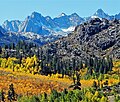Mount Wallace (Fresno and Inyo counties, California)
| Mount Wallace | |
|---|---|
 Northwest aspect | |
| Highest point | |
| Elevation | 13,377 ft (4,077 m)[1] |
| Prominence | 337 ft (103 m)[1] |
| Parent peak | Mount Haeckel (13,418 ft)[2] |
| Isolation | 0.39 mi (0.63 km)[2] |
| Listing | Sierra Peaks Section |
| Coordinates | 37°08′49″N 118°39′24″W / 37.1468068°N 118.6567979°W[3] |
| Naming | |
| Etymology | Alfred Russel Wallace |
| Geography | |
| Location | Kings Canyon National Park Fresno County / Inyo County California, U.S. |
| Parent range | Sierra Nevada |
| Topo map | USGS Mount Darwin |
| Geology | |
| Rock age | Cretaceous |
| Mountain type | Fault block |
| Rock type | granitic |
| Climbing | |
| First ascent | July 16, 1895 |
| Easiest route | class 3[2] |
Mount Wallace is a 13,377-foot-elevation (4,077 meter) mountain summit located on the crest of the Sierra Nevada mountain range in northern California, United States.[3] It is situated on the shared boundary of Kings Canyon National Park with John Muir Wilderness, and along the common border of Fresno County with Inyo County. It is 21 miles (34 km) west of the community of Big Pine, 1.38 miles (2.22 km) northwest of Mount Powell, 0.5 miles (0.80 km) southwest of Picture Peak, and 0.37 miles (0.60 km) southeast of Mount Haeckel, which is the nearest higher neighbor.[1] Mount Wallace ranks as the 79th-highest summit in California,[2] and the ninth-highest in the Evolution Region.[1]
History
[edit]In 1895, Sierra Club explorer Theodore S. Solomons named a group of mountains in the Sierra Nevada after exponents of Darwin's theory of evolution.[4][5] These six peaks are now known collectively as the Evolution Group. Solomons wrote: "At a distance of two miles it [the wall of Mount Darwin] rises perpendicularly five or six hundred feet, forming Mt. Haeckel, and a mile beyond again rises several hundred feet higher, though not quite so sharply, forming the peak called Mt. Wallace... Next morning [July 16, 1895] we climbed Mt. Wallace."[6] This mountain is named for Alfred Russel Wallace (1823–1913), a British naturalist, explorer, geographer, anthropologist, and biologist who is best known for developing the theory of evolution contemporaneously with Darwin.[7] The other five peaks were named after Charles Darwin, John Fiske, Ernst Haeckel, Herbert Spencer, and Thomas Henry Huxley.
The 1895 climb by Theodore Solomons and party was the first ascent of the summit.[8]
Climate
[edit]Mount Wallace is located in an alpine climate zone.[9] Most weather fronts originate in the Pacific Ocean, and travel east toward the Sierra Nevada mountains. As fronts approach, they are forced upward by the peaks, causing them to drop their moisture in the form of rain or snowfall onto the range (orographic lift). Precipitation runoff from this mountain drains northeast into Bishop Creek, and west into Evolution Creek, which is a San Joaquin River tributary.
Gallery
[edit]See also
[edit]References
[edit]- ^ a b c d "Mount Wallace, California". Peakbagger.com. Retrieved 2021-06-20.
- ^ a b c d "Wallace, Mount - 13,377' CA". listsofjohn.com. Retrieved 2021-06-20.
- ^ a b "Mount Wallace". Geographic Names Information System. United States Geological Survey, United States Department of the Interior. Retrieved 2021-06-20.
- ^ Francis Peloubet Farquhar, Exploration of the Sierra Nevada, 1925, California Historical Society, page 47.
- ^ Browning, Peter (1986). Place Names of the Sierra Nevada. Berkeley: Wilderness Press. p. 67. ISBN 0-89997-119-9.
- ^ Francis P. Farquhar, Place Names of the High Sierra (1926)
- ^ Peter Browning, Place Names of the Sierra Nevada From Abbot to Zumwalt, 1986, Wilderness Press, ISBN 9780899970479.
- ^ Alan M. Hedden and David R. Brower, A Climber's Guide to the High Sierra (1954)
- ^ "Climate of the Sierra Nevada". Encyclopædia Britannica.
External links
[edit]- Weather forecast: Mount Wallace




